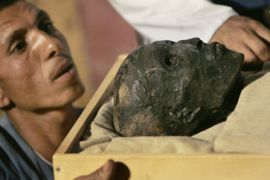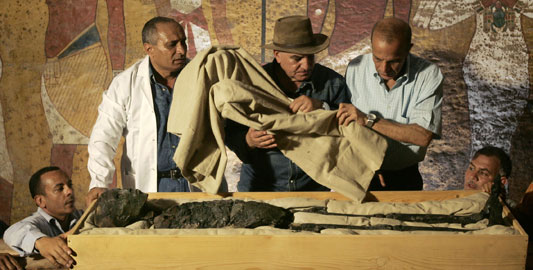King Tut faces his public
Egyptian boy pharoah’s face revealed 3,000 years after his mysterious death.

 |
| “King Tut’s” discovery in 1922 caused an international sensation [AFP] |
The face of ancient Egypt’s boy king Tutankhamun has finally been revealed to the public for the first time since he died in mysterious circumstances more than 3,000 years ago.
The pharaoh’s mummy was moved from its ornate sarcophagus in the tomb to a nearby climate-controlled case where experts say it will be better preserved.
Keep reading
list of 4 itemsBirth, death, escape: Three women’s struggle through Sudan’s war
Does Israel twist humanitarian law to justify Gaza carnage?
Vatican denounces gender-affirming surgery, gender theory and surrogacy
The discovery of “King Tut’s” mummy in 1922 caused an international sensation.
“The face of the golden pharaoh is amazing,” Zahi Hawass, Egypt’s head of antiquities, said as he pulled back the linen bandages to reveal a body resembling a badly burnt skeleton.
“It has magic, it has mystery, it has beauty and his buck teeth are similar to the rest of his family’s. Putting the mummy in this case will make the golden king live forever.”
Believed to have been made pharaoh and the 12th ruler of ancient Egypt at the age of nine, Tutankhamun became famous with the discovery of his tomb and the treasures within by Howard Carter.
‘Beautiful face’
“What you will see is a beautiful face,” Mustafa Wazery, the director of the Valley of the Kings, told journalists ahead of the mummy’s displacement. “He’s a good-looking boy, with a nice smile and buck teeth.”
A highly publicised museum exhibit will open later this month in London followed by a US tour that starts at the Dallas Museum of Art.
Scientists began restoring King Tut’s badly damaged mummy more than two years ago.
Much of the mummy’s body is broken into 18 pieces, Hawass said.
He fears that mass tourism may deteriorate King Tut’s mummy further as thousands of tourists visit the underground chamber every month.
“The humidity and heat caused by … people entering the tomb and their breathing will change the mummy to a powder. The only good thing in this mummy is the face. We need to preserve the face,” Hawass said.
Egypt’s tourism industry is hoping to capitalise on the public’s fascination in King Tut and draw tourists to Luxor to see the boy king.
More than 9 million tourists visited Egypt last year.